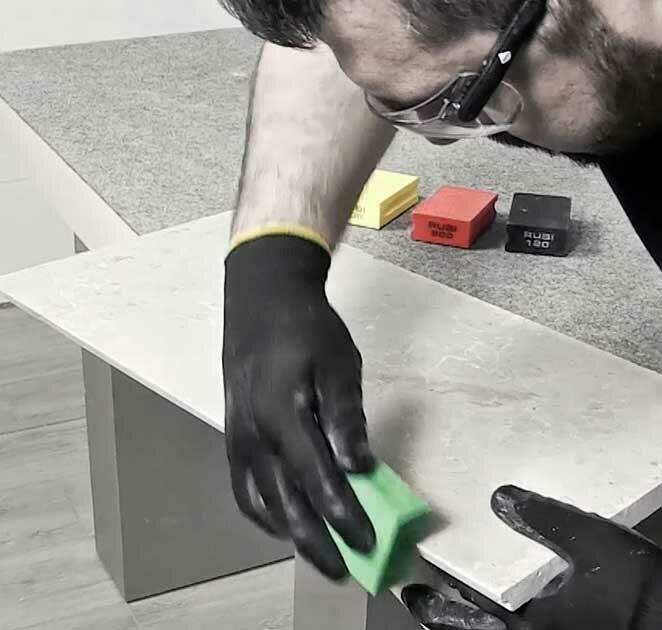You’re looking to install tiles on the ceiling for a bathroom renovation or even an office makeover, but you aren’t sure how to cut ceiling tiles. What now? Don’t worry – we’ve got you covered. Today we’re diving into the essentials of tool selection, maintenance, and safety, ensuring your path to a flawless ceiling is not only achievable but enjoyable! Read this article to find out how to cut ceiling tile for your next tile installation.


Essential Tools and Materials
To cut ceiling tiles like a pro, you need the right tools. Think of it like gathering your ingredients before you start cooking. You’ll need a few key items to do a good job.
A tile cutter, T-square or straight edge, and measuring tape are your basic toolkit. Each tool has its special role in making sure your cuts are clean and your tiles fit perfectly. So while there’s no best tool to cut ceiling tiles, there are a bunch that you’ll need.
A tile cutter is your go-to for making straight cuts. It’s designed to score the tile so you can snap it cleanly. Using a T-square or a straight edge helps you keep your cuts straight. It’s like having a guide that ensures you’re cutting in a straight line, which is crucial for a professional look. And of course, a measuring tape is essential.
You’ll use it to measure your ceiling space and your tiles, so you know exactly where to cut.
But having the best tools isn’t enough. You also need to take care of them. Keeping your tools clean and in good shape means they’ll last longer and work better.
For example, changing the scoring wheel on your tile cutter as needed keeps it sharp and makes cutting easier. Storing your tools properly protects them from damage.
Preparing to Cut Ceiling Tiles
Before you start cutting your ceiling tiles, getting everything ready is key. Think of it as setting the stage for your work.
The first step is measuring and marking your tiles accurately.
This step is super important. You want to make sure you measure and cut ceiling tiles so that they will fit perfectly in their spot on the ceiling.
Use your measuring tape to find the right size and then use a pencil to mark where you need to cut.
Setting up your workspace is another big part of the preparation. You need a flat and clean surface to work on. Ensure that there are no holes in the ceiling.
These steps help you make precise cuts and keep your tiles in good shape in the long run.
Also, safety is a big deal. You should wear safety goggles to protect your eyes from dust and gloves to keep your hands safe.
When you’re measuring your tiles, remember to leave a little extra space for the grout lines. The grout is important and makes the installation much more durable. Having it in mind during planning helps you put the tile in place without too much trouble later.
Getting ready like this might seem like a lot of steps, but it’s all about making the cutting process smooth and safe. With everything measured, marked, clean, and flat, your workspace is ready and you’re all set to start cutting.

Cutting Techniques and Tips
For straight cuts, your tile cutter and straight edge will be your best friends.
First, use your measuring tape to find where you need to cut. Then, use your straight edge to draw a line on the tile.
This line is your guide. With the tile cutter, score along this line. You don’t need to cut all the way through. Just a deep score will do.
Then, gently snap the tile along the scored line. It should break neatly where you scored it.
Angled Cuts
Angled cuts are a bit trickier. They’re often needed for corners or special fittings. The key here is to measure the angle carefully. Use your pencil to mark the cutting line on the tile.
Follow the line when scoring with your tile cutter. Then, just like with straight cuts, snap the tile gently along the scored line.
Take your time with these cuts. They require a bit more patience.
Tips for Smooth and Clean Cuts
Always score with constant pressure, keeping in mind that you shouldn’t have to push super hard. A well made tile cutter with the proper scoring wheel should be able to cut ceiling tile easily. A dull scoring wheel can also jeopradize your cuts.
Keep a vacuum nearby to clean up dust as you go. This keeps your workspace clear and helps you see your cutting lines better.
Troubleshooting Common Issues
Even with careful planning, you might run into issues like cracked tiles or uneven edges. If a tile cracks, you might be scoring too hard or too soft. Have a few extra tiles at the beginning to practice cutting and see the best scoring force.
For uneven edges, use a diamond pollishing pad to smooth out the edges.

Tile Cutting Safety
Working with ceiling tiles means you’re dealing with sharp tools and materials that can break or splinter. Keeping safe is a big part of doing a good job. Think of safety gear as your personal shield against the unexpected.
First up, personal protective equipment (PPE) is a must.
Safety goggles are important because they protect your eyes from dust and any tiny pieces that fly up when you’re cutting tiles. And don’t forget about your hands.
Gloves keep your fingers safe from cuts and scrapes. There are different kinds of gloves, so pick ones that are tough enough to protect you but also let you move your fingers freely.
When you’re using tools like tile cutters, knowing how to handle them safely is key. This helps prevent accidents from misuse.
Also, use a steady grip and apply even pressure. Rushing or pushing too hard can cause mistakes and injuries.
Your workspace matters a lot, too. Keep it clean and free of clutter.
This means you have plenty of room to work and you’re less likely to trip or fall. And when you’re cutting tiles, do it in an area where it’s okay to make a bit of a mess. Some materials can be pretty dusty.
How to Cut Ceiling Tiles Like a Pro
Mastering how to cut ceiling tiles is within your reach. But you’re now equipped with the know-how on tool selection, precise cutting techniques, and essential safety practices.
Embrace this skill with confidence, knowing you have the foundation to achieve professional-looking results in your own space.
RUBI is a leading manufacturer of equipment and tools for laying tiles and construction. Let us help you with information about all your tiling needs!



Post a comment